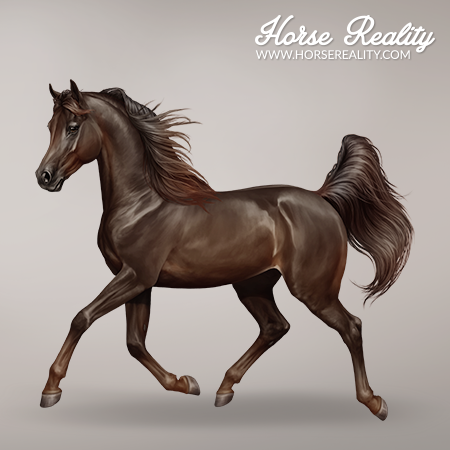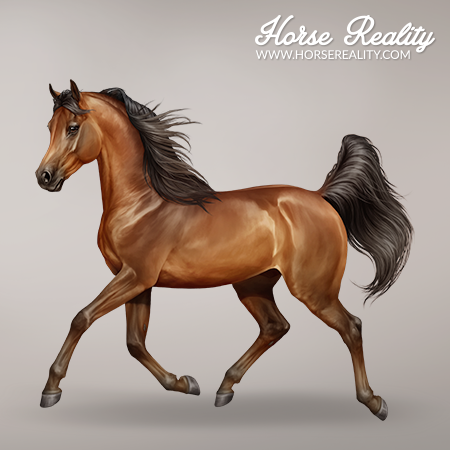Sooty is one of the different modifiers that can affect the colour of horses.
¶ Phenotype
Sooty, also sometimes called smutty, causes a darkening of the coat colour on chestnut and bay-based horses. It can be expressed in many different ways and often looks different between chestnut and bay-based horses.
On chestnut-based horses, especially on palominos, it often mostly darkens the legs or lower body, making the legs look like they are muddy. Sooty can also change the entire coat colour to a dark shade of brown; sometimes the coat can be so dark it almost looks black. This is often referred to as liver chestnut. Palomino horses with a coat completely darkened by sooty are also called chocolate palomino. Sooty can also darken the manes and tail of the horse, sometimes making them darker than the body. This may cause the manes and tail of flaxen chestnuts and palominos to look “dirty”, or even the same shade as the body. Sooty can cause pronounced dappling on the coat as well.
| Sooty on chestnut bases - Arabian Horse | |

|

|
On bay-based horses, sooty often mainly affects the topline and upper part of the body - as if someone dumped a bucket of soot on them. This may cause a broad fake “dorsal stripe”, as is seen in dun horses. This effect is called countershading and may help camouflage horses to protect them from predators. Some sooty horses also show a darker ”face mask". Just like on chestnuts, sooty can cause pronounced dapples on the coat of bay-based horses. The degree of sootiness can vary between horses, some have extensive sooty all over the body.
Especially these dark sooty bays can sometimes look similar to seal brown. If sooty and seal brown are both present, the horse could be so dark it appears to be black. However, areas around the muzzle, eye, flanks and other soft parts are lighter coloured, often more yellowish. Buckskins or brown buckskins can also be so dark that they could get mistaken for just (sooty) bays or seal browns. Sooty wild bays may show an expression similar to some sooty chestnuts, with mainly their lower body being affected.
| Sooty on bay bases - Arabian Horse | |

|

|

|

|
In real life, sooty seems to increase its expression as the horse ages and often shows seasonal changes as well. On Horse Reality, sooty does not show this progression as the horse gets older. Rather, they are born with their original coat colour, which changes into a sooty coat as they turn into an adult (3 years old). They retain this shade for the rest of their life. This may also lead to some surprises, as a foal's colour could unexpectedly change drastically once they age up!
This fact may help us differentiate sooty bays from seal browns - seal browns are already born with their dark colour, while sooty horses are not. It can also help identify us sooty buckskin horses.
¶ Genotype
The genetic cause of sooty has not yet been discovered in real life, it may even be polygenic (multiple genes). Therefore, it also remains untestable and hidden in the game.
In Horse Reality, the sooty gene is responsible for causing the darkening of the coat. The dominance of the sooty-alleles (STY, sty), however, differs between breeds and sometimes even between coat colours. Sooty may be a dominant trait on bay bases, for example, while being recessive on chestnut bases. It may show in combination with other dilutions or modifiers in some breeds, but not in others.
¶ Breeds
Sooty is likely present in most horse breeds. The following table lists all breeds that can currently have the sooty allele in-game:
| Breeds |
| Akhal-Teke Horse |
| Arabian Horse |
| Brabant Horse |
| Brumby Horse |
| Camargue Horse |
| Cleveland Bay |
| Exmoor Horse |
| Finnhorse |
| Fjord Horse |
| Friesian Horse |
| Haflinger Horse |
| Icelandic Horse |
| Irish Cob Horse |
| Kladruber Horse |
| Knabstrupper |
| Lipizzaner |
| Lusitano |
| Mongolian Horse |
| Mustang Horse |
| Namib Desert Horse |
| Noriker Horse |
| Norman Cob |
| Oldenburg Horse |
| Pantaneiro Horse |
| Pura Raza Española |
| Quarter Horse |
| Shetland Pony |
| Shire Horse |
| Suffolk Punch |
| Thoroughbred |
| Trakehner Horse |
| Welsh Pony |
¶ References
- Bellone R., Sponenberg D. P., Equine Color Genetics, 4th Edition, 2017, Wiley-Blackwell